Amr El Mokhtar, Maha Sabry
Faculty of Engineering, Alexandria UniversityAlexandria-Egypt
Correspondence to: Maha Sabry, Faculty of Engineering, Alexandria UniversityAlexandria-Egypt.
| Email: |  |
Copyright © 2012 Scientific & Academic Publishing. All Rights Reserved.
Abstract
The WIMAX technology based on air interface standard 802-16 wireless MAN is configured in the same way as a traditional cellular network with base stations using point to multipoint architecture to drive a service over a radius up to several kilometers. The coverage range and the speed of WIMAX make the system very attractive for users and enterprises, especially for VOIP services so,we examine how well WIMAX is suited to support one of the most promising applications - Voice over IP VoIP. Though, the medium access control (MAC) layer of WIMAX has been standardized, there are certain features which can be tuned and made specific to an application and/or channel conditions. We exploit the flexibility present in the MAC layer of 802.16a for construction and transmission of MAC protocol data units (MPDU) for supporting multiple VoIP streams over a single WIMAX link. Since, VoIP streams are both delay and loss sensitive we study a delay added when we use Turbo, CPC and combination of both. In this paper, a comparison between the performance of WIMAX using convolutional Product code (CPC), turbo codes and combination of them (CPC)[1] is made. Then we study R score (measure for quality of services when send VOIP over WIMAX)----{-improve} and we notice that delay factor for turbo code is less than CPC but on other hand that the most important factor for R-score is packet losses which is slightly better when using convolutional product code (CPC) than Turbo codes especially for when we use pseudo interleaver.
Keywords:
Turbo Codes, VOIP, WIMAX
Cite this paper: Amr El Mokhtar, Maha Sabry, Studying R-Score of Voip Streams over Wimax Using Convolutional Product Code (CPC) VS Turbo Codes, Electrical and Electronic Engineering, Vol. 3 No. 5, 2013, pp. 123-127. doi: 10.5923/j.eee.20130305.01.
1. Introduction
WIMAX[3] is a new wireless technology that provides high throughput broadband connection over long distances based on IEEE.802.16 wireless MAN air interface standard. It is designed to accommodate both fixed and mobile broadband applications. It can be used for many applications, including "last mile" broadband connections, hotspots and cellular backhaul, and high-speed enterprise connectivity for business, due to its high spectrum efficiency and robustness in multi path propagation. Comparing WIMAX to Wi-Fi and 3G, the wimax has an improved important characteristic, the throughput capabilities of wimax depends on the channel bandwidth used[4]. Unlike the 3G systems which have fixed channel bandwidth, WIMAX defines a selectable channel bandwidth from 1.25MHz to 20MHz. In WIMAX systems, there are many researches had been made for the different stages such as coding stage[5-9]. Our investigations are focused on studying the performance of wimax using convolutional product code (CPC) compared to turbo code. In the CPC coding method, a stream of bits, forming the message, is converted into a matrix (nxm). First each row will be coded by recursive systematic convolutional encoder. After interleaver, each column will be coded by another recursive systematic convolutional encoder. The same or different generator polynomials are used to code both rows and columns. CPC will be described in more details in section III. In this paper, CPC method is studied for improving BER at different SNR for WIMAX system. The comparison between this method and turbo code will be investigated. Moreover a combination between CPC and turbo code will be done also studying Turbo codes using different interleaving methods such as block, spread and pseudo. These different code methods will be used at different modulation techniques (BPSK/QPSK and). Then In this paper, we examine how well WiMax is suited to support one of the most promising applications - Voice over IP VoIP. Though, the medium access control (MAC) layer of WiMax has been standardized, there are certain features which can be tuned and made specific to an application and/or channel conditions. We exploit the flexibility present in the MAC layer of 802.16a for construction and transmission of MAC protocol data units (MPDU) for supporting multiple VoIP streams over a single WiMax link. Since, VoIP streams are both delay and loss sensitive we study a delay added when we use Turbo, CPC and combination of both.Paper is organized as follows: in Section 2, description of physical layer of WIMAX, section 3, description of Turbo codes, section 4, description of CPC, section 5, VOIP and R score, section 6, section 7, delay and losses sensitivity for VOIP , section 8, and finally Section 9, conclusion.
2. Physical Layer of WIMAX
The downlink transmission using the wireless Man is being considered. Wimax system depends on OFDMA physical layer as specified in the IEEE .802.16 standard[10]. A block diagram of the physical layer of wimax is depicted in Fig. 1. The binary data bits after randomization are fed into the encoder. The turbo encoder or CPC will be used in this stage. After interleaving, the sequence of binary bits, is fed into the modulator for mapping which means converting them to a sequence of complex values and modulating them by QPSK, BPSK/QPSK. By this procedure the OFDM symbols are constructed in the frequency domain, and then Inverse Fast Fourier Transform (IFFT) is used for converting them into the time domain.
3. Description of Turbo Code
The fundamental turbo encoder Fig.1 is built using two identical Recursive Systematic Convolutional (RSC) encoders with parallel concatenation[11,12]. An RSC encoder has a rate equals 1/2 and is termed a component encoder, the two component encoders are separated by an interleaver. Only one of the systematic outputs from the two component encoders is used.In this paper, a turbo code with rate 1/3 is used for encoding the message. The two (RSC) encoders that form the turbo coder, are separated by an interleaver, both of them has generator polynomials (1,5/7), constraint length 3 and code rate 1/2 Fig. 3.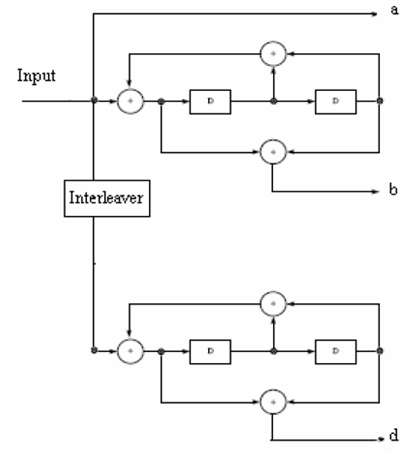 | Figure 1. Simple Turbo coder structure |
4. Description of CPC Method
CPC is a new coding method in which the information bits are placed into two dimensions (2D) matrix. The rows and the columns are encoded separately by using recursive systematic.Convolutional encoders. The same recursive systematic convolutional code is used to encode each row. Once all rows have been encoded, the matrix is sent, if desired, to an interleaver. Our original data matrix dimensions are (n×k), and the encoded data matrix dimensions will be (2n×k). The coded rows matrix is then recoded column by column using the same or different recursive systematic convolutional encoder. CPC uses a recursive systematic convolutional code with rate 1/2 and generator polynomials (1,5/7) octal to encode each row and column Fig. 5. Hence, the overall code rate will be1/4.In this work, the same technique is used for coding the c message, except we use nonrecursivenonsystematic convolutional encoder instead of recursive systematic convolutional encoders for coding both rows and columns. The sequence of bits is fed into 2D matrix and fills it column by column. The size of this matrix will be (nx4) for BPSK/QPSK and (nx6) for, to simplify the process of mapping, as the symbol size in BPSK/QPSK is 4 bits and in is 6 bits. So each row will form one symbol. The 'n' refers to the number of data subcarriers of OFDM, 128 or 512. The coding by CPC will be done in 2 stages. First each column will be independently coded, and then each row of the resulting matrix will be recorded by the same generator polynomials. The generator polynomials used for coding both rows and columns are (5,7) with constraint length 3, not following the standard of WIMAX, Figure 6. Each column is padded with two zeros for terminating its encoder but each row is padded with two or three zeros according to the number of used subcarriers, 128 or 512, receptively to form the suitable size of the overall matrix. That matrix is then divided into smaller matrices with sizes (nx4) or (nx6) as described later. Figure 6 Convolutional coding[5,7] The reason for using nonrecursivenonsystematic convolutional encoder instead of recursive systematic convolutional encoders is simplifying the termination of the encoder, as RSC contains a feedback and its termination will be more difficult. Also using the generator polynomials (5,7) leads to a little increase in the complexity of the system because of a few number of zeros will be added to terminate the two encoders. After coding, the total number of bits will be more than the original message's bits as the overall code rate becomes 1/4, and the zeros added to both column and rows for termination process. At the receiver, the three OFDMA symbols are combined to form the original matrix which is decoded by Viterbi decoder, that uses the same generator polynomials (5,7) with hard decision for each row then for each column to obtain the results shown in Figures 1,2 . To match the CPC method,the number of data bits will be reduced due to the number of zero bits added to terminate the two encoders. The advantages of this method are,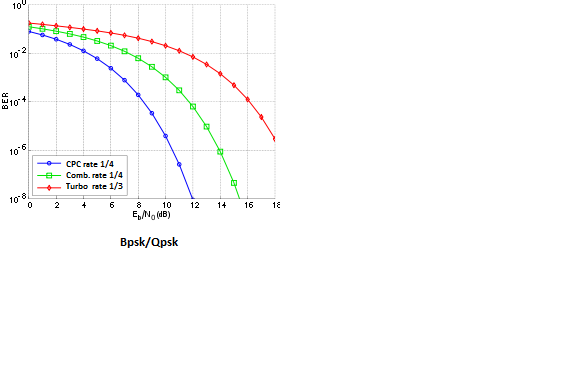 | Figure 2. Bit error rate for Turbo codes, CPC code andcombination of Turbo codes |
1. Do not need another interleaver after channel coding because of converting into matrix (nx4) or (nx6) do almost the same job as the overall matrix will be filled column by column and will be read row by row after coding processes (block interleaver) since each row is used for making QAM symbol. 2. Reducing the BER. But on the other hand it causes more delay for obtaining the original message because the code rate becomes ¼ not 1/2 as convolutional code so the system will be more complex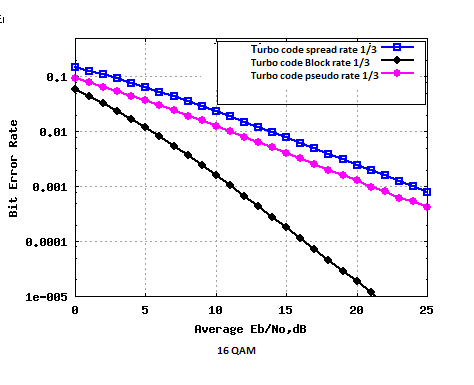 | Figure 3. Bit error rate for Turbo codes using different interleaving methods “Spread, Block and pseudo” |
Also a combination between turbo code and CPC is done. In this type of coding the CPC is used directly without any modification which means using RSC for code both rows and columns with generator polynomial (1,5/7) and constrain length 3. This type of coding will have code rate=1/4. Figure 2. In Figure 3 we study BER for turbo codes using different interleaver types block, spread and pseudo with 16 QAM modulations we found that BER enhancement observed in pseudo. In Figure 4 shows BER in different N iterations for turbo codes. | Figure 4. Bit error rate for turbo codes for different N=2048,512, in different iterations “ 6 and 3” |
5. R-score
Regarding of the growing rate of data services, voice services still remain the major revenue earner for the serviceproviders. However, providing voice services wireless or otherwise, require infrastructures that are usually very expensive. Therefore, efforts are being made to deliver voice services over the already existing IP infrastructure which is viewed as an easy and cheap solution. Supporting voice over IP has many challenges. Real-time applications like VoIP require minimum service guarantees that go beyond the best-effort structure of today’s IP networks.Though some codecs are capable of some level of adaptation and error concealment, VoIP quality remains sensitive to performance degradation in the network.
5.1. Quality of VoIP
A typical VoIP application works as follows. First, a voice signal is sampled, digitized, and encoded using a given algorithm/ coder. The encoded data (called frames) is packetized and transmitted usingRTP/UDP/IP. At the receiver’s side, data is de packetized and forwarded to a playout buffer, which smoothes out the delay incurred in the network. Finally, the data is decoded and the voice signal is reconstructed. The quality of the reconstructed voice signal is subjective and therefore is measured by the mean opinion score (MOS). MOS is a subjective quality score that ranges from 1 (worst) to 5 (best) and is obtained by conducting subjective surveys. Though these methods provide a good assessment technique, they fail to provide an on-line assessment which might be made use for adaptation purpose. The ITU-T E-Model[4] has provided a parametric estimation for this purpose. It defines an R-factor[4],[5] that combines different aspects of voice quality impairment. It is given by | (1) |
where Is is the signal-to-noise impairments associated with typical switched circuit networks paths, Ie is an equipment impairment factor associated with the losses due to the codecs and network, Id represents the impairment caused by the mouth-to-ear delay, and A compensates for the above impairments under various user conditions and is known as the expectation factor. It is to be noted that the contributions to the R-score due to delay and loss impairments are separable. This does not mean that the delay and loss impairments are totally uncorrelated, but only their influence can be measured in isolated manner. Expectation factor covers intangible and almost impossible to measure quantities like expectation of qualities. However, no such agreement on measurement of expectation on qualities has still been made and for this reason expectation factor is always dropped from the R factor equation in all studies of VoIP. The R-factor ranges from 0 to 100 and a score of more than 70 usually means a VoIP stream of decent quality. The R-score is related to MOS through the following non linearmapping[4] | (2) |
for 0 ≤ R ≤ 100. If R < 0, MOS takes the value of 1, and similarly, if R > 100, MOS takes the value of 4.5.Among all the factors in equation (1), only Id and Ie are typically considered variables in VoIP[5]. Using default values for all other factors[4], the expression for R-factor given by equation (1) can be reduced to | (3) |
5.2. Delay and Loss Sensitivity of VOIP
Let us study how end-to-end delay (consisting of codec delay, network delay, and playout delay) andtotal loss probability (consisting of loss in the network and playout loss at the receiver’s decoder buffer) affect the VoIP call quality, i.e., the R-score.
5.2.1. Effect of Delay
In a VoIP system, the total mouth-to-ear delay is composed of three components: codec delay (dcodec), playout delay (dplayout), and network delay (dnetwork). Codec delay represents the algorithmic and packetization delay associated with the codec and varies from codec to codec. For example, the G729.a codec introduces a delay 25 ms delay. Playout delay is the delay associated with the receiver side buffer required to smooth out the delay for the arriving packet streams. Network delay is the one-way transit delay across the IP transport network from one gateway to another. Thus the total delay is | (4) |
The delay impairment Id depends on the one way mouth to- ear delay encountered by the VoIP streams. This mouth to- ear delay, denoted by Id, determines the interactivity of voice communication. Its impact on voice quality depends on a critical time value of 177.3 ms, which is the total delay Budget (one way mouth-to-ear delay) for VoIP streams. The effect of this delay is modeledas[5], | (5) |
Where H(x) is an indicator function: H(x) = 0 if x < 0, and 1 otherwise.
5.2.2. Effect of Loss
VoIP call quality is also dependent on the loss impairment. Recall, Ie represents the effect of packet loss rate. Ie accounts for impairments caused by both network and receiver’s playout losses. Different codecs with their unique encoding/decoding algorithms and packet loss concealment techniques yield different values for Ie. We use the model as proposed in[5],[6] that relate Ie to the overall packet loss rate as | (6) |
Where γ1 is a constant that determines voice quality impairment caused by encoding, and γ2 and γ3 describe the impact of loss on perceived voice quality for a given codec. Note that e includes both network losses and playout buffer losses, which can be modeled as, | (7) |
Where, enetwork is the loss probability due to the loss in the network and eplayout is loss probability due to the play out loss at the receiver side.
5.3. Sensitivity of R-score towards Delay and Loss
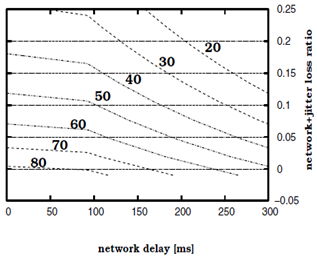 | Figure 5. R score For VOIP quality for Loss and delay |
We show the sensitivity of both delay and loss in Figure .5 we show the R-scores between 20 and 80 with the jitter buffer being 60 ms. it is evident that VoIP call quality is more sensitive towards loss than the delay. For constant loss and with increase in delay, call quality degrades very slowly. But for the reverse case, i.e., for constant delay, with increase in loss, the R-factor drops significantly. This difference in sensitivity is the primary motivation for the mechanism that is proposed at the MAC layer of WiMax.Also we study Id using NS2 for the previous coding we found that turbo codes had the lowest Id as shown in figure 6.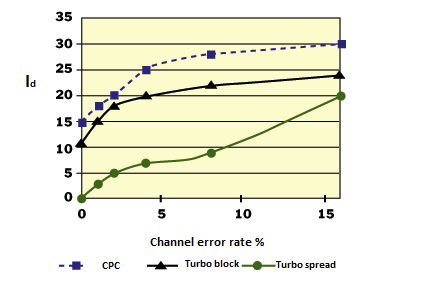 | Figure 6. ID value for different coding typesCpc , Turbo codes using Block and spread interleavers |
6. Conclusions
In this paper, performance of wimax systems is studiedunder using CPC and Turbo using different interleaverscoding method. This method leads to reduce BER at any SNR. We investigated the effects of this method at different modulation schemes (BPSK/QPSK) and for different number of OFDMA sub carriers (128-512), it gives a good improvement. For example at BER equals to 10-2 for BPSK/QPSK, 128 subcarriers and BPSK/QPSK, 512 subcarriers, the amount of improvements in SNRapproximately equal to2 dB better thanconvolutional code.Also we study The R-score for these different codes and we found that R-score is a slightly better for turbo codes
References
| [1] | IEEE. Standard 802.16-2005, Part 16: Air interface for fixed and mobile broadband wireless access systems, December 2005. |
| [2] | OrhanGazi and Ali ÖzgürYılmaz “Turbo Product Codes Based onConvolutional Codes” ETRI Journal, Volume 28, Number 4, August2006. |
| [3] | J.Andrews, A.Ghosh, and R.Muhamed “fundamentals of wimax:understanding broadband wirelessnetworking ” .Prentic Hallcommunication engineering and emerging series February 2007. |
| [4] | Jeffrey G Andrews. Arunabha Ghosh .Rias Muhamed Fundamentals of WIMAX ” |
| [5] | ChanglongXu “Soft Decoding Algorithm for RS-CC Concatenated Codes in WIMAX System” Vehicular Technology Conference, 2007. |
| [6] | Improving the R-score of an adaptive VoIP codec in IEEE 802.16 networks Jen-Yi Pan, Tsung-Yin Lee, Wen-Sung Lee, Chin-YaTsaoJanuary 2013, Volume 52, Issue 1, pp 285-297 |
| [7] | TorbenBrack, Matthias Alles, Frank Kienle, Norbert Wehn “A SYNTHESIZABLE IP CORE FOR WIMAX 802.16E LDPC CODE DECODING” The 17th Annual IEEE International Symposium on Personal, Indoor and Mobile Radio Communications (PIMRC’06),2006. |
| [8] | Gunnam, K.K. Choi, G.S. Yeary, M.B. Atiquzzaman, M. “VLSI Architectures for Layered Decoding for Irregular LDPC Codes of WiMax” Communications, 2007. ICC '07. IEEE International Conference ,2007. |
| [9] | Salmon, B.P.; Olivier, J.C. “Performance Analysis of Low Density Parity-Check Codes on a WiMAX Platform” Wireless Communications and Networking Conference, 2007.WCNC 2007. IEEE. |
| [10] | Lin, Zhang; Shunzheng, Yu. “Turbo Codes for 10-66GHz WiMax Systems” International Journal of Infrared and Millimeter Waves, Volume 26, Number 8, August 2005. |
| [11] | EEE. Standard 802.16-2004, Part 16: Air interface for fixed broadband wireless access systems, June2004. |
| [12] | Divsalar, D. and Pollara, F., “On the Design of Turbo Codes,” TDA Progress Report 42-123, Jet Propulsion Laboratory, Pasadena, California, November 15, 1995, pp. 99-121. |
| [13] | Pietrobon, S., “Implementation and Performance of a Turbo/MAP Decoder,”Int’l. J. Satellite Commun., vol. 16, Jan-Feb 1998, pp. 23-46. |
| [14] | Divsalar, D. and Pollara, F., “Multiple Turbo Codes for Deep-Space Communications,” TDA Progress Report 42-121, Jet PropulsionLaboratory, Pasadena, California, May 15, 1995, pp. 66-77. |
| [15] | Improving R-Score of VoIP Streams overWiMaxShamikSengupta and Mainak Chatterjee School of Electrical Engineering and Computer Science University of Central FloridaOrlando, FL 32816-2450Email: {shamik, mainak} @ cpe. ucf.edu |
| [16] | Improving Quality of VoIP Streams overWiMaxShamikSengupta,StudentMember,IEEE, Mainak Chatterjee, and SamratGanguly ,EEE TRANSACTIONS ON COMPUTERS, VOL. 57, NO. 2, FEBRUARY 2008 |














 Abstract
Abstract Reference
Reference Full-Text PDF
Full-Text PDF Full-text HTML
Full-text HTML